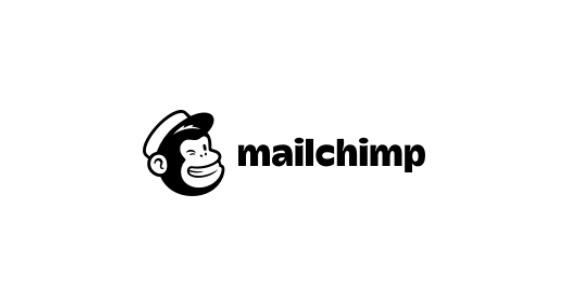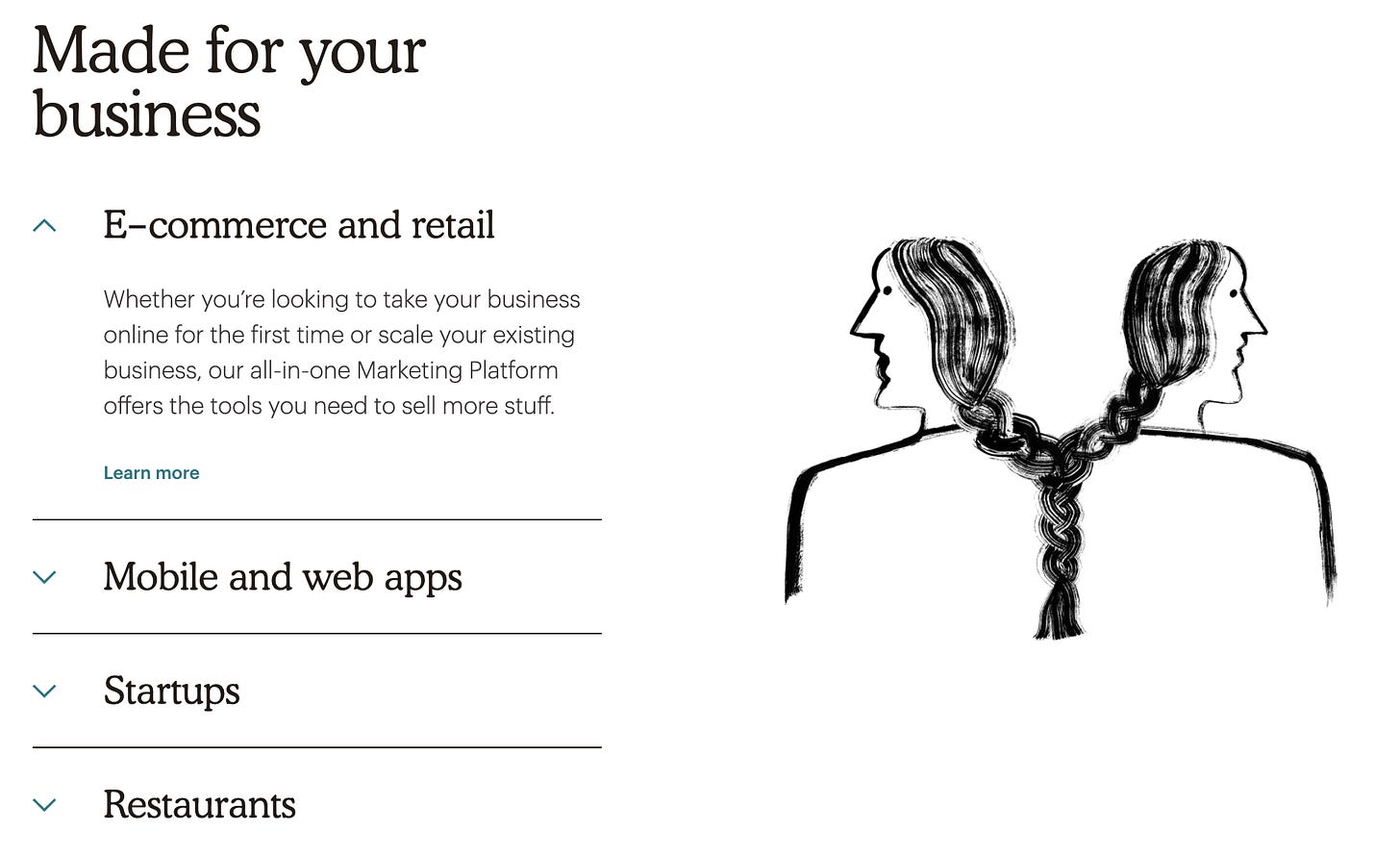SaaS Pricing is hard. PricingSaaS is your cheat code.
Monitor competitors, track real-time benchmarks, discover new strategies, and more.
You’ve probably noticed newsletters are having a moment.
Before starting one myself, I subscribed to so many of them. For the past decade, newsletters have been my favorite way to receive content. I love that they’re delivered straight to me, in the warm confines of my inbox.
Early on, there was one stamp at the bottom of pretty much every newsletter I subscribed to:
Everyone used Mailchimp. Including Ben Thompson, the author of one of my longtime favorites: Stratechery.
For a while, Thompson’s weekly podcast with James Alworth, Exponent, was sponsored by Mailchimp. Thompson’s ad-reads sounded like love letters to the company. He even alluded to the day that he had to upgrade to the paid version as a day of celebration.
Mailchimp’s free plan has a limit of 2,000 subscribers, so crossing that threshold was a serious milestone for Stratechery. Because of this testimonial, I’ve always considered Mailchimp the freemium dream. You know your packaging is aligned with your customers’ goals when they celebrate having to pay for your software.
Since their free plan also gives users room to grow at no cost, it seemed like Mailchimp’s grip on the newsletter game was unassailable.
However, over the last couple years something funny happened. The Mailchimp monkey has become an endangered species in my inbox. Right now, I can count on one hand how many newsletters I get that are sent through Mailchimp.
Now, I’m only one person, with a particular taste in content, so it's not lost on me that this might not be the case globally. However, I do believe it’s significant. Simply put, Mailchimp isn’t the best option on the market for newsletters any more. While there are several players, there are two companies that I believe are at the forefront of Mailchimp’s declining edge: Substack and ConvertKit.
To be clear, these companies don’t pose an existential threat to Mailchimp. They do, however, provide a great example of how companies can drive adoption by honing in on a specific use case and tailoring their product, packaging, and positioning to serve it.
The Two Schools of Newsletter
While both Substack and ConvertKit are key players in the rising passion economy, they serve different schools of thought.
Substack (what I use to send this newsletter) optimizes for writer simplicity. The platform streamlines technical configuration so that all writers have to do is write. This is ideal for me because I don’t want to spend time building out my own personal website and cobbling together the tech stack to support it. I just want something that makes it easy for me to publish consistently. Substack does exactly that.
There are a few trade-offs to this approach.
First, to use Substack you have to work from the Substack domain. That means all the SEO credit goes to Substack, not the writers using the platform.
Another trade-off is customization. Substack only allows one font and very limited formatting choices. It also doesn’t integrate with, well, anything.
Combined, these factors form the overarching tradeoff to using Substack: lack of ownership. If you want to own your domain, build SEO authority, and limit platform risk, you’re going to want to use something else.
That’s where ConvertKit comes in...
ConvertKit offers a suite of tools to build a newsletter infrastructure yourself. They also offer a wide range of integrations to fill the gaps they can’t provide. ConvertKit is for the DIY creator that wants to own their domain, capture all of the SEO credit, and limit platform risk.
The biggest tradeoff with ConvertKit is it takes work. You need to design your own emails, landing pages, and forms, and make it all work together. For someone like me who just wants to write, it feels like a hassle despite the advantages of ownership.
It’s important to note that Mailchimp offers more customization, integrations, and advanced functionality than either challenger. Many would argue they’re superior to both from a product perspective.
So why are people using Substack and ConvertKit instead?
Two Ways to Differentiate
Let’s start with Substack.
Remember Mailchimp’s freemium dream? Substack shattered it.
While Mailchimp’s value metric, subscribers, is tied closely to customer success, Substack takes it a step further. They have skin in the game, and only make money if you make money with their platform. When a writer goes from free to paid, that moment of celebration goes from, “Oh nice, I have 2,000 subscribers” to “Oh shit, I just made my first dollar writing on the internet!”
That is powerful. Equally powerful is the prospect that Substack can be free forever if you never adopt a paid subscription model for your newsletter.
The combination of a streamlined product and “skin in the game” pricing allowed Substack to drive early adoption from two core groups. First, they captured high-quality writers looking to monetize their skills independently. Second, they inspired a wave of new writers to join the platform by reducing the friction to getting started.
This fusion of professional journalists, deep thinkers, and fresh voices has led to a high-quality signal associated with the Substack brand. The Substack stamp is aspirational and acts as a magnet for new writers that decide they want to enter the ring themselves. As a result, Substack has become the first stop for budding writers in the newsletter gold rush.
ConvertKit serves a different segment.
While Substack is geared specifically towards writers, ConvertKit positions itself as the platform for any creator to build an audience online.
While Substack’s value lies in making it frictionless to publish, ConvertKit built their entire product around helping creators make their vision a reality. All of their features, from landing pages to list management to automated sequences, aim to help creators turn their side hustle into a real business.
Alongside their product, ConvertKit offers live and on-demand trainings to teach creators the fundamentals of building an audience online, and how to use their platform to do it. Their strategy integrates education with product, positioning ConvertKit as more than just software. ConvertKit’s CEO, Nathan Barry, is a serial creator, giving the brand credibility and anchoring the trainings and software to his own real-life experience.
Though their approaches differ widely, Substack and ConvertKit share a singular focus on a specific type of customer, allowing them to serve that group better than Mailchimp.
So, what about Mailchimp?
There’s no question Mailchimp sees what’s happening here. The thing is, it’s pretty inevitable. Their strategy is broadly focused on serving small businesses and is generally use-case agnostic.
Their website names a wide, random list of verticals that can benefit from the software.
It begs the question, if Mailchimp was made for all of these businesses, was it really made for any of them?
It brings to mind JJ Oslund’s piece, The Verticalization of Zoom, which highlights the long tail of companies carving out niche verticals in video-conferencing.
However, Zoom is doing just fine, and being able to serve a wide range of verticals isn’t a bad thing. While Substack and ConvertKit are perfect for their specific use-cases, there are tons of companies they’ll never serve. Email is a vast market, and newsletters make up just a small sliver of the overall landscape.
For Mailchimp, serving a variety of use cases may mean that getting unbundled was inevitable, but it also means there are plenty of other customers they can help. Even with Substack, ConvertKit, and others making a dent in their dominance, Mailchimp is still very much in the mix in newsletters. As long as they remain in the mix across a wide range of use-cases, they’ll still have a very lucrative business.
That’s why even though the Mailchimp monkey has been slowly disappearing from my inbox for some time now, I don’t think we’ll have to worry about the little guy going extinct anytime soon.
Enjoying Good Better Best?
If you enjoyed this post, I’d love it if you hit the “like” button, that way I’ll know which posts are resonating the most!
If you have thoughts or feedback, I’d love to hear from you! You can find me on Twitter here.








I used to use Mail Chimp and switched to Mailer Lite more recently while trying to grow. Mail Chimp has become so complicated and convoluted it does too much I honestly got the the point of not knowing how to use it 😂 Mailer Lite on the other hand I am really enjoying for its simplicity 👍 I have heard amazing things about Convert Kit but not free enough for me. A lot of talk of Substack taking customers and readers from Medium which I find really interesting.